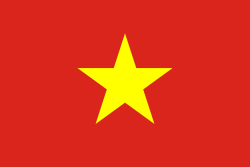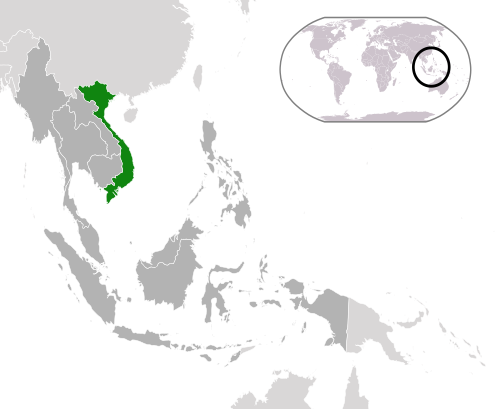Vietnam
The Socialist Republic of Vietnam (or just Vietnam) (Vietnamese: [Cộng hòa Xã hội chủ nghĩa Việt Nam] Error: {{Lang}}: text has italic markup (help)) is a country in Southeast Asia. The neighboring countries are Cambodia, China, and Laos. The capital is Hanoi. The most populous city is Ho Chi Minh City. There are about 99,497,680 people living in Vietnam.[15] Vietnam was united under a communist government. In 1986, the government made economic and political changes that began Vietnam's path to be a part of the world economy.[16] Since 2000, Vietnam's economic growth has been among "the highest in the world",[16] and in 2011 it had the highest global growth generator index among 11 "major" economies.[17]
Socialist Republic of Vietnam Cộng hòa Xã hội chủ nghĩa Việt Nam (Vietnamese) | |
|---|---|
| Motto: "Independence – Freedom – Happiness" | |
| Anthem: | |
Location of Vietnam (green) in the Southeast Asia | |
| Capital | Hanoi 21°2′N 105°51′E / 21.033°N 105.850°E |
| Largest city by municipal boundary | Da Nang 16°20′N 107°35′E / 16.333°N 107.583°E |
| Vietnamese[1] | |
| Ethnic groups (2019) |
|
| Religion (2019) |
|
| Demonym(s) | Vietnamese Viet (colloquial) |
| Government | Unitary Marxist–Leninist one-party socialist republic[5] |
| Tô Lâm | |
| Lương Cường | |
| Phạm Minh Chính | |
| Trần Thanh Mẫn | |
| Legislature | National Assembly |
| Formation | |
• Văn Lang | 7th century BC |
• Âu Lạc | 3rd century BC |
| 111 BC | |
| 939 | |
| 1428 | |
• Nguyễn's unification | 1802 |
| 25 August 1883 | |
| 2 September 1945 | |
| 21 July 1954 | |
| 30 April 1975 | |
| 2 July 1976 | |
• Đổi Mới | 18 December 1986 |
| 28 November 2013[c] | |
| Area | |
• Total | 331,344.82[7][d] km2 (127,932.95 sq mi) (66th) |
• Water (%) | 6.38 |
| Population | |
• 2023 estimate | 100,300,000[10][11] (15th) |
• 2019 census | 96,208,984[2] |
• Density | 298/km2 (771.8/sq mi) (49th) |
| GDP (PPP) | 2024 estimate |
• Total | |
• Per capita | |
| GDP (nominal) | 2024 estimate |
• Total | |
• Per capita | |
| Gini (2022) | ▼ 36.1[13] medium |
| HDI (2023) | high · 93rd |
| Currency | Vietnamese đồng (₫) (VND) |
| Time zone | UTC+07:00 (Vietnam Standard Time) |
| Driving side | right |
| Calling code | +84 |
| ISO 3166 code | VN |
| Internet TLD | .vn |
Geography
The length of the country, from North to South, is 1,650 kilometers (1,025 miles).[18] "At its narrowest point, Vietnam is only 30 miles (48 kilometers) wide".[19] Northern Vietnam offers a "humid" subtropical climate with 4 seasons (winter, spring, summer, and fall) while Southern Vietnam is "hot year-round".[20]
History
In A.D. 40, the Trưng Sisters Trưng Trắc and Trưng Nhị led a rebellion to get rid of Tô Định, the Chinese governor occupying Vietnam. They were daughters of a Lạc lord in Giao Chỉ (now Northern Vietnam) and widows of aristocrats. They successfully formed their own kingdom in Mê Linh, where Trưng Trắc was proclaimed queen, and a capital was built for her".[21] While ruling in Mê Linh, the sisters abolished taxes. They were defeated in A.D. 43 by Ma Yuan, a Chinese general, and are regarded as female military heroes and national heroines.[22]
After Ma Yuan’s defeat of the Trung sisters, the Chinese maintained domination over Vietnam for more than a thousand years. They established a bureaucracy that emphasized Confucianism, and they focused on educating Vietnam’s ruling class with Chinese literature and ideas.[23]
The kings of Champa (Chiêm Thành in Vietnamese) started construction of Hindu temples at Mỹ Sơn in the 4th century AD.[24][25]
France desired trading freedom in Vietnam. They wanted to bring more missionaries into the country. The Nguyen dynasty disliked French involvement in Vietnam, and executed missionaries and Vietnamese coverts. This spurred the French Emperor, Napoleon III, to attack Vietnam and attempt to force the court to accept the title of "French protectorate." By the 1880s Vietnam was officially a French protectorate.[26]
The nation was divided into North Vietnam and South Vietnam. After independence was achieved, the French gave the land of the Mekong delta that was part of Cambodia to South Vietnam. The United States had influence in the South, and the Việt Minh controlled the North. Hồ Chí Minh became President of the Democratic Republic of (North) Việt Nam. It was agreed that the nation would be reunited by elections in 1956. The Americans and the Southern government stopped the elections from happening because they expected Hồ Chí Minh to win because North Vietnam refused to hold free elections. Dwight Eisenhower said he thought Hồ would win with around 80% of the vote if elections were held because of the majority of the population being in the north added with Hồ's supporters in the South.[27]
Population
In Vietnam, the approximate population is around 99,298,522 to 101,531,681 people.[28][29] The Vietnamese male population is 50,205,096 and the female population is 51,326,584.[29] 25.2% of these people are aged between 0-14, with 13,365,800 being male and 12,161,135 being female. 69.3% of the population are between the ages of 15-64. The male-to-female ratio is 35,024,433 being male and 35,156,146 being female. 5.5% are 65 and over, with 2,149,957 being male and 3,459,991 being female. So within the older 2 categories, there are more women than men.[30]
Science and technology
Media said in 2011 that investment in science and technology was 2% of GDP.[31]
"Vietnam provides no incentives for students to return to Vietnam from their foreign graduate programmes" was the opinion (in 2011) of French physicist Pierre Darriulat.[31][32]
Vietnam Media
Official recording of the National Anthem of Vietnam (Music of the song Tien Quan Ca, composed by: Van Cao). Vietnamese law strictly prohibits any organization or individual, in any form, from taking action to prevent or hinder the dissemination of this work directly or indirectly (including online).
Đại Việt, Champa, Angkor Empire and their neighbours, late 13th century
Vietnam's territories around 1838, during the Vietnamese occupation of Cambodia
Capture of Saigon by Charles Rigault de Genouilly on 18 February 1859
The Grand Palais built for the 1902–1903 world's fair, when Hanoi became French Indochina's capital
Three US Fairchild UC-123B aircraft spraying Agent Orange during the Operation Ranch Hand as part of a herbicidal warfare operation depriving the food and vegetation cover of the Việt Cộng, c. 1962–1971
Notes
References
| This language has its own Wikipedia project. See the Vietnam edition. |
- ↑ "Vietnam". The World Factbook. Central Intelligence Agency. 18 April 2023. Archived from the original on 10 June 2021. Retrieved 27 April 2023.
- ↑ 2.0 2.1 2.2 General Statistics Office of Vietnam 2019.
- ↑ 2022 Report on International Religious Freedom: Vietnam (Report). Office of International Religious Freedom, United States Department of State. 2022. Archived from the original on 11 February 2024. Retrieved 11 February 2024.
- ↑ Vietnam Government Committee for Religious Affairs, 2018, cited in "2019 Report on International Religious Freedom: Vietnam". United States Department of State. Archived from the original on 26 September 2020. Retrieved 12 October 2020.
- ↑ "Constitution of the Socialist Republic of Vietnam". FAOLEX Database. Food and Agriculture Organization. Archived from the original on 20 January 2024. Retrieved 20 January 2024.
The Constitution defines Vietnam as [having] a socialist rule of law, State of the people, by the people, and for the people. Vietnam is a unitary state ruled by [a] one-party system with coordination among State bodies in exercising legislative, executive and judicial rights.
- ↑ Viet Nam News 2014.
- ↑ "Phê duyệt và công bố kết quả thống kê diện tích đất đai năm 2022" [Approval and announcement of land area statistics for 2022]. DecisionNo. 3048/QĐ-BTNMTof18 October 2023 (PDF) (in Tiếng Việt). Ministry of Natural Resources and Environment (Vietnam).[dead link]
- ↑ "Vietnam". The World Factbook. Central Intelligence Agency. 17 January 2024. Archived from the original on 10 June 2021. Retrieved 23 January 2024.
- ↑ "Vietnam country profile". BBC News. 24 February 2020. Archived from the original on 28 May 2020. Retrieved 27 January 2021.
- ↑ Socio-economic situation in the fourth quarter and 2023 (Report). General Statistics Office of Vietnam. 29 December 2023. Archived from the original on 12 February 2024. Retrieved 12 February 2024.
- ↑ An Chi (31 December 2023). "Dân số trung bình của Việt Nam năm 2023 đạt 100,3 triệu người" (in vi). Nhân Dân. https://nhandan.vn/dan-so-trung-binh-cua-viet-nam-nam-2023-dat-1003-trieu-nguoi-post789936.html. Retrieved 12 February 2024.
- ↑ 12.0 12.1 12.2 12.3 "World Economic Outlook Database, April 2024 Edition. (Vietnam)". www.imf.org. International Monetary Fund. 16 April 2024. Archived from the original on 16 April 2024. Retrieved 17 April 2024.
- ↑ "Gini index - Viet Nam". World Bank Group.
- ↑ "Human Development Report 2025" (PDF). United Nations Development Programme. 6 May 2025. Archived (PDF) from the original on 6 May 2025. Retrieved 6 May 2025.
- ↑ "Vietnam Population 1950-2023". www.macrotrends.net. Retrieved 18 August 2023.
- ↑ 16.0 16.1 Vietnam's new-look economy. BBC News. 18 October 2004. http://news.bbc.co.uk/2/hi/asia-pacific/3752682.stm. Retrieved 21 November 2015.
- ↑ Weisenthal, Joe (22 February 2011). "3G Countries". Business Insider. Retrieved 6 August 2011.
- ↑ "How Big is Vietnam in Comparison to the United States, Germany, Japan and UK?". 26 February 2014. Archived from the original on 21 September 2017. Retrieved 28 September 2017.
- ↑ "Vietnam". Kids. 25 March 2014.
- ↑ "Best Time to Visit Vietnam: Weather isn't Everything! [2021]". 17 November 2021. Retrieved 2 December 2021.
- ↑ Seekins, Donald M., "Trung Sisters, Rebellion of (39–43)", in Sandler, Stanley, ed., Ground Warfare: An International Encyclopedia (Santa Barbara California: ABC-Clio, hardcover 2002 (ISBN 1-57607-344-0)), vol. 3, p. 898, col. 1 (author of Seekins of Meio University).
- ↑ Sarah Womack (1995). "The remakings of a legend: women and patriotism in the hagiography of the Tru'ng sisters". Crossroads. 9 (2): 31–50. JSTOR 40860533.
- ↑ Sarah Womack (1995). "The remakings of a legend: women and patriotism in the hagiography of the Tru'ng sisters". Crossroads. 9 (2): 31–50. JSTOR 40860533.
- ↑ "KINGDOM OF CHAMPA". Archived from the original on 3 May 2012. Retrieved 28 September 2017.
- ↑ Andrew David Hardy, Mauro Cucarzi, Patrizia Zolese Champa and the Archaeology of Mỹ Sơn 2009
- ↑ "Vietnam History, People, Economy, Geography, Government." Vietnam History, People, Economy, Geography, Government. N.p., n.d. Web. 30 Apr. 2014. http://vietventures.com/Vietnam/history_vietnam.asp Archived 2014-07-30 at the Wayback Machine
- ↑ "Eisenhower's Views on the Popularity of Ho Chi Minh". www.mtholyoke.edu. Archived from the original on 30 October 2019. Retrieved 11 February 2019.
{{cite web}}: Unknown parameter|archive- url=ignored (help) - ↑ "Viet Nam Population (2019) - Worldometers". www.worldometers.info. Retrieved 22 February 2019.
- ↑ 29.0 29.1 "Vietnam population (2023) live — Countrymeters". countrymeters.info. Retrieved 29 August 2023.
- ↑ "CIA The World Fact Book". Archived from the original on 17 May 2020. Retrieved 10 May 2011.
- ↑ 31.0 31.1 Stemming the outflow of talent. 16 September 2011. https://www.economist.com/babbage/2011/09/16/stemming-the-outflow-of-talent.
- ↑ "Website Under Maintenance". en.baomoi.com. Archived from the original on 2 January 2012. Retrieved 28 September 2017.
Cite error: There are <ref> tags on this page, but the references will not show without a {{Reflist|group=lower-alpha}} template or a <references group="lower-alpha"/> tag.








